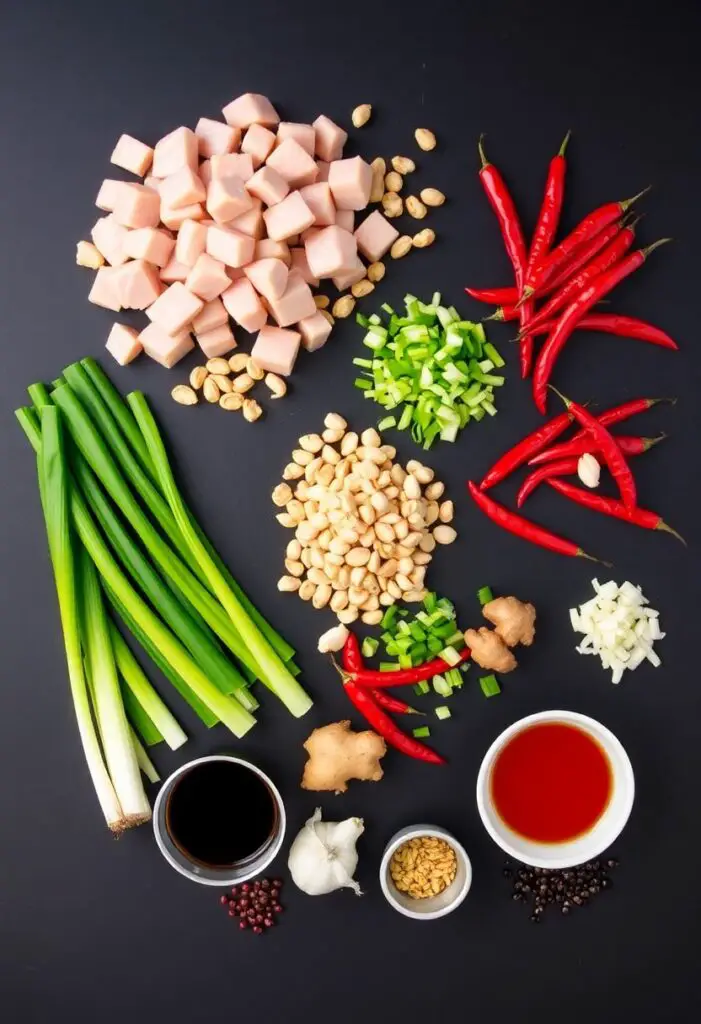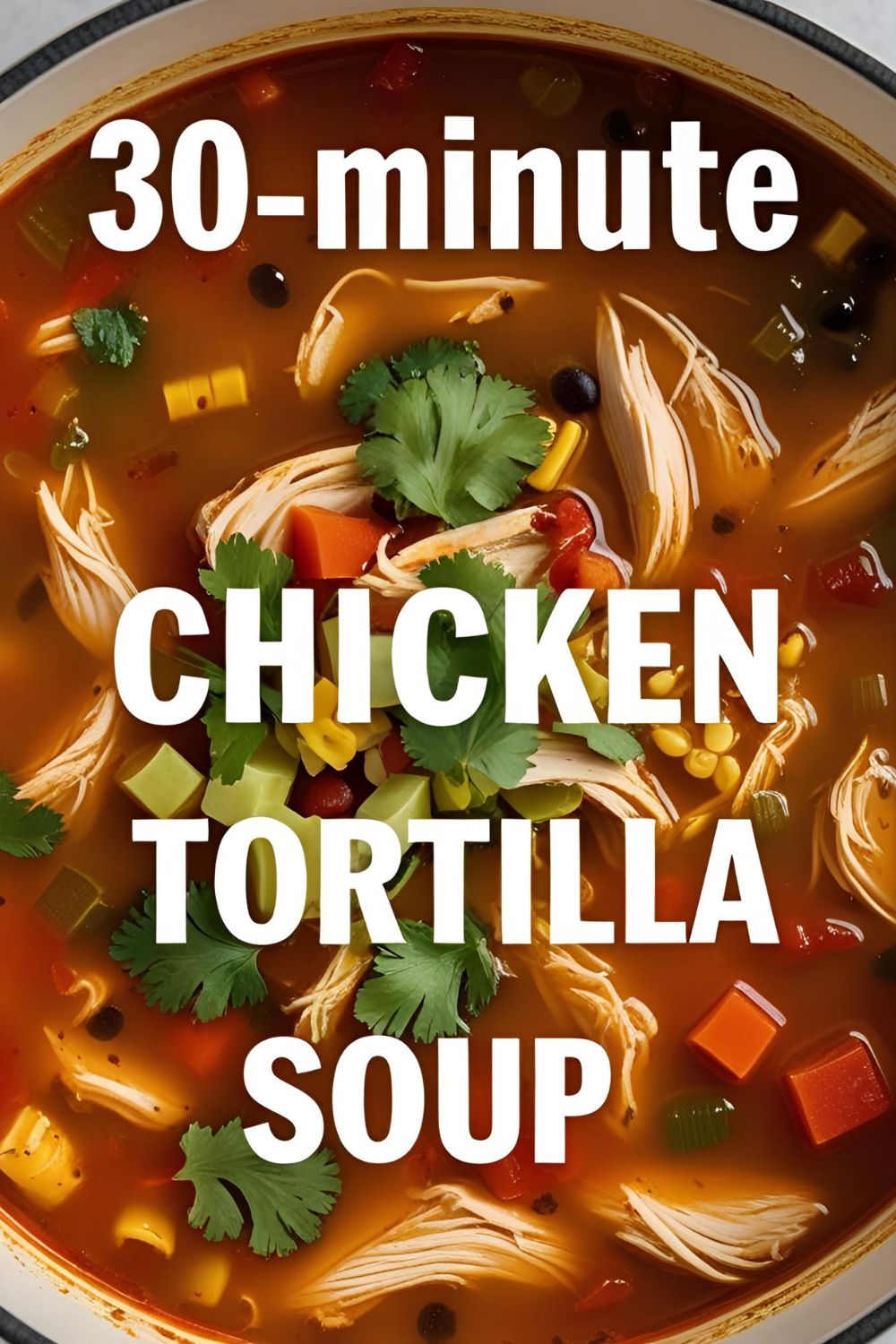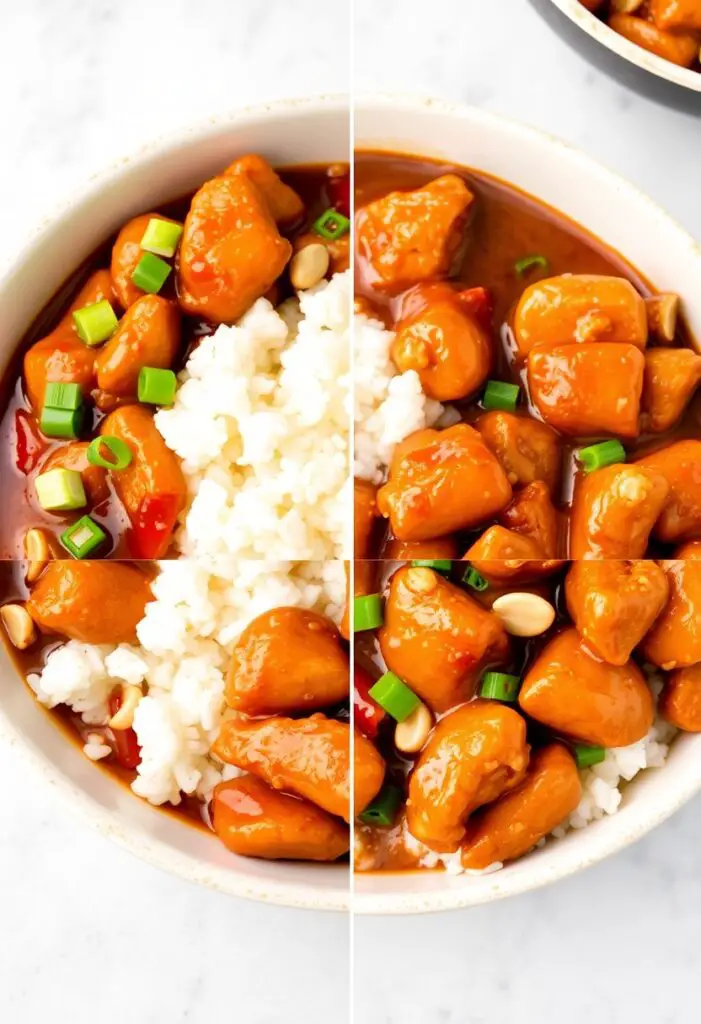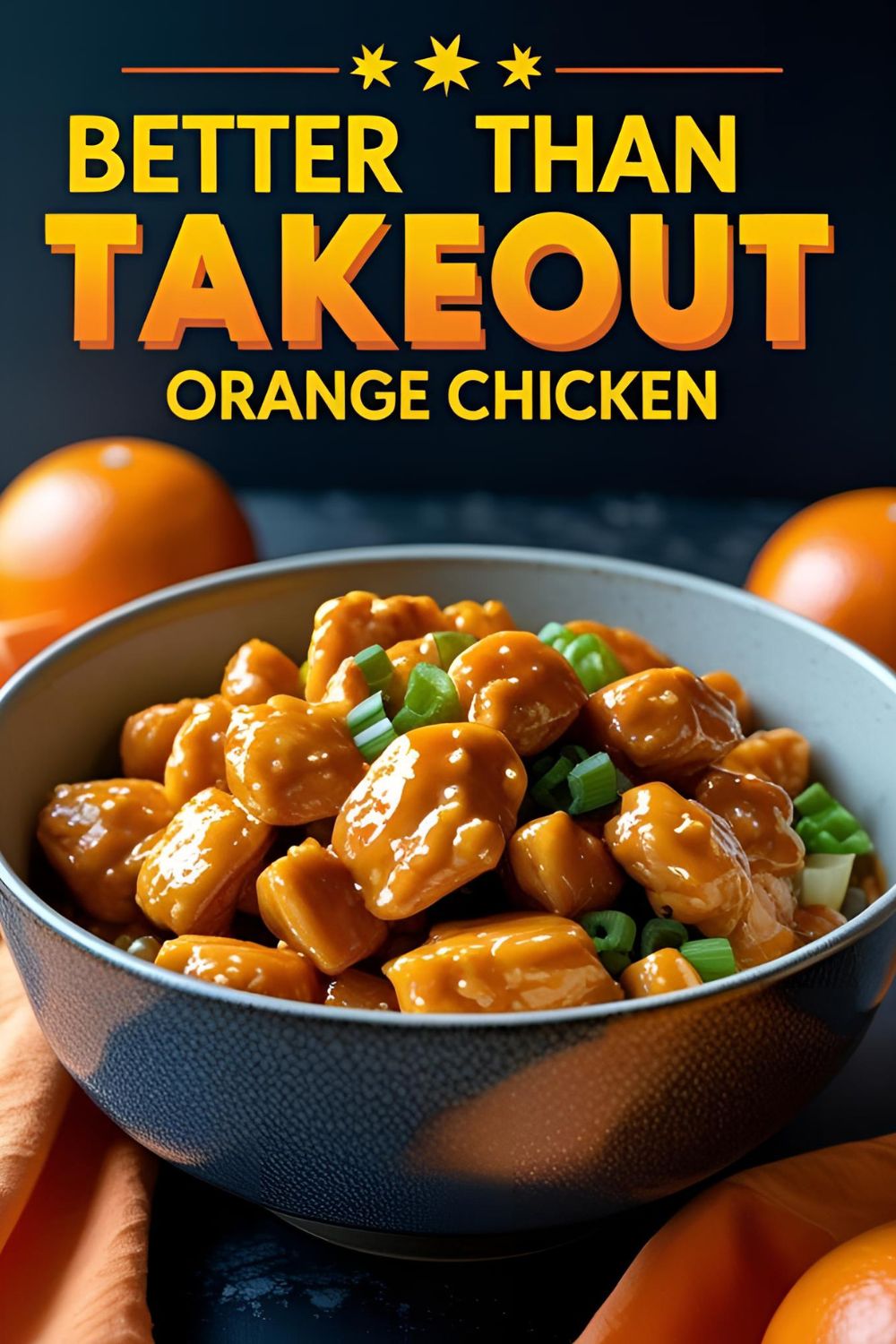Why Homemade Kung Pao Chicken Will Rock Your World (and Maybe Impress Your Dates)
Why should you bother making Kung Pao chicken at home when you can just order it? Oh, let me enlighten you, my friend.
First, freshness is the name of the game. You control every ingredient, so you know exactly what’s going into your dish. No mystery meat or sauces that have been simmering since last Tuesday. Just vibrant, fresh flavors that pop.
Second, you can customize the spice level. Are you a chili fiend who wants to breathe fire? Go ahead and add more peppers! Prefer a milder experience? Dial it back. You’re the boss of your own Kung Pao destiny.
Finally, it’s surprisingly quick and satisfying to make. Once you’ve prepped your ingredients, this dish comes together in a flash. Plus, the feeling of accomplishment when you nail that perfect balance of flavors? Priceless. (Though, you know, you still have to do the dishes.)
The Kung Fu of Ingredients
Here’s what you’ll need to unleash your inner culinary ninja.
For the Chicken Marinade:
- Boneless, Skinless Chicken Thighs or Breasts: 1 pound, cut into ½-inch cubes (thighs tend to stay juicier, just sayin’).
- Soy Sauce: 1 tablespoon (go for low sodium if you’re watching the salt).
- Rice Vinegar: 1 teaspoon (don’t substitute with regular vinegar, it’s different!).
- Cornstarch: 1 teaspoon (this helps with tenderness and sauce thickening).
- White Pepper: ¼ teaspoon (adds a subtle heat, but black pepper works in a pinch).
For the Sauce:
- Soy Sauce: 2 tablespoons.
- Rice Vinegar: 2 tablespoons.
- Hoisin Sauce: 1 tablespoon (adds a sweet and savory depth).
- Sugar: 1 teaspoon (balances the savory elements).
- Sesame Oil: 1 teaspoon (for that nutty aroma).
- Chicken Broth or Water: 2 tablespoons.
- Cornstarch: 1 teaspoon (to thicken the sauce).
For the Stir-Fry:
- Dried Red Chili Peppers: 5-10, depending on your spice preference (remove seeds for less heat).
- Sichuan Peppercorns: 1 teaspoon (these add a unique numbing sensation – trust me, it’s awesome!).
- Peanuts: ½ cup, roasted and unsalted (salted will work, just adjust seasoning).
- Scallions: 2-3, white and green parts separated and chopped.
- Garlic: 2 cloves, minced.
- Ginger: 1 teaspoon, minced (fresh is always best!).
- Vegetable Oil or Peanut Oil: For stir-frying.
Substitution Notes:
- Chicken: Firm tofu, cut into cubes, can be marinated and stir-fried for a vegetarian version.
- Hoisin Sauce: If you can’t find it, a mix of soy sauce, honey, and a touch of peanut butter can work in a pinch, but it won’t be quite the same.
- Sichuan Peppercorns: If you absolutely can’t find them, you can omit them, but you’ll miss out on that signature tingly sensation.
- Peanuts: Cashews or other nuts can be substituted, but peanuts are traditional.
The Wok Warrior’s Arsenal (Tools & Kitchen Gadgets)
Gear up for some serious stir-frying action!
- Wok or Large Skillet: A wok is ideal for stir-frying due to its shape and ability to distribute heat evenly, but a large, flat-bottomed skillet will also work.
- Cutting Board.
- Sharp Knife.
- Several Small Bowls: For prepping ingredients and sauces.
- Measuring Spoons and Cups.
- Spatula or Stir-Fry Tool.
- Serving Plates.
Step-by-Step to Kung Pao Perfection
Ready to wok this way? Let’s do it!
Step 1: Marinate the Chicken (The Flavor Bath)
In a medium bowl, combine the cubed chicken, soy sauce (1 tbsp), rice vinegar (1 tsp), cornstarch (1 tsp), and white pepper. Toss everything together and let it marinate for at least 15 minutes, or up to 30 minutes while you prep the other ingredients.
Step 2: Whisk Up the Sauce (The Flavor Bomb)
In a separate small bowl, whisk together the soy sauce (2 tbsp), rice vinegar (2 tbsp), hoisin sauce, sugar, sesame oil, chicken broth (or water), and cornstarch (1 tsp). Set this aside – you’ll want it ready to go when you start stir-frying.
Step 3: Prep the Stir-Fry Ingredients ( Mise en Place, My Friend)
Chop your dried red chili peppers (remove seeds if desired), mince the garlic and ginger, and separate the white and green parts of the scallions. Have your Sichuan peppercorns and peanuts ready. Having everything prepped before you start cooking is crucial for stir-frying!
Step 4: Stir-Fry the Aromatics (The Scent Sensation)
Heat about 1-2 tablespoons of vegetable oil or peanut oil in your wok or skillet over medium-high heat until it’s shimmering. Add the dried red chili peppers and Sichuan peppercorns. Stir-fry for about 30 seconds to 1 minute, until the peppers turn a deep red and become fragrant. Be careful not to burn them! Burnt peppers taste bitter.
Step 5: Cook the Chicken (The Protein Powerhouse)
Add the marinated chicken to the wok and stir-fry over medium-high heat until it’s cooked through and lightly browned, about 3-5 minutes. Make sure you don’t overcrowd the wok; cook in batches if necessary to ensure the chicken browns nicely.
Step 6: Add the Garlic and Ginger (The Flavor Boost)
Push the chicken to one side of the wok or remove it temporarily. Add the minced garlic and ginger to the hot oil and stir-fry for about 15-20 seconds until fragrant. Again, watch out – burnt garlic is no bueno.
Step 7: Introduce the Sauce (The Flavor Fusion)
Pour the prepared sauce into the wok and bring it to a simmer, stirring constantly. The sauce will thicken quickly due to the cornstarch.
Step 8: Toss It All Together (The Grand Finale)
Return the cooked chicken to the wok. Add the peanuts and the white parts of the scallions. Toss everything together to coat evenly with the sauce.
Step 9: Serve and Garnish (The Delicious Delivery)
Remove the Kung Pao chicken from the heat and transfer it to serving plates. Garnish with the green parts of the scallions. Serve hot with steamed rice. And try not to inhale it all in one go. (Though, no judgment if you do.)
Calories & Nutritional Info (The Moderation Morsel)
Keep in mind that these are estimates and can vary based on portion size and specific ingredients used.
- Serving Size: Approximately 1 ½ cups.
- Estimated Calories: 400-550 (depending on oil and rice serving).
- Main Components: Protein, carbohydrates (from rice and sauce), healthy fats (from peanuts and oil), and some sugar.
- Nutritional Notes: Provides a good source of protein. Be mindful of sodium content from soy sauce and hoisin.
Common Mistakes to Avoid (Don’t Let Your Kung Pao Go Wrong)
- Not Having Everything Prepped: Stir-frying is fast! If you’re scrambling to chop garlic while your chicken is burning, you’re gonna have a bad time. Mise en place is your friend.
- Overcrowding the Wok: This lowers the temperature and leads to steaming instead of stir-frying. Cook in batches if necessary.
- Burning the Chilies or Garlic: These aromatics add fantastic flavor, but burnt bits taste bitter and ruin the dish. Keep a close eye on them.
- Using Too Much Oil: While oil is needed for stir-frying, using excessive amounts will make the dish greasy.
- Adding the Peanuts Too Early: The peanuts can get soggy if added too early in the cooking process. Add them towards the end for maximum crunch.
- Substituting Regular Vinegar for Rice Vinegar: They have very different flavor profiles. Stick with rice vinegar for that authentic tang.
Variations & Customizations (Your Kung Pao, Your Rules)
Want to put your own spin on this classic? Go for it!
1. Extra Spicy Kung Pao
Add more dried red chili peppers (consider using hotter varieties!) or a dash of chili oil to the sauce for an extra fiery kick. You can even add some fresh chili peppers along with the garlic and ginger.
2. Shrimp Kung Pao
Substitute the chicken with peeled and deveined shrimp. Marinate the shrimp briefly and stir-fry until pink and cooked through. Adjust cooking times as shrimp cooks much faster than chicken.
3. Keto-Friendly Kung Pao
Reduce or eliminate the sugar in the sauce and use a sugar substitute. Increase the amount of vegetables like bell peppers or zucchini. Serve over cauliflower rice instead of regular rice.
FAQ Section: Your Kung Pao Queries, Quelled
Let’s tackle those Kung Pao conundrums!
1. What makes Kung Pao chicken spicy? The spiciness comes primarily from the dried red chili peppers that are stir-fried in oil, infusing the dish with heat.
2. What are Sichuan peppercorns and why are they used? Sichuan peppercorns have a unique citrusy aroma and create a tingling, numbing sensation in the mouth, which is a signature characteristic of authentic Sichuan cuisine.
3. Can I make Kung Pao chicken without peanuts? Yes, you can omit the peanuts if you have an allergy or simply don’t like them. Cashews are a common substitution, or you can just skip the nuts altogether.
4. What’s the best oil to use for stir-frying Kung Pao chicken? Vegetable oil or peanut oil are good choices due to their high smoke points, which are necessary for stir-frying over high heat.
5. How do I store leftover Kung Pao chicken? Store leftovers in an airtight container in the refrigerator for up to 3-4 days. Reheat thoroughly in a skillet or microwave before serving.
6. Can I add more vegetables to Kung Pao chicken? Absolutely! Bell peppers, onions, carrots, and zucchini are all great additions. Add them to the wok after the chicken has been cooked.
7. Is Kung Pao chicken naturally gluten-free? No, traditional soy sauce contains wheat. To make it gluten-free, use tamari or a gluten-free soy sauce substitute.
Final Thoughts
Alright, my friend, you’re now armed with the knowledge to whip up a seriously delicious batch of homemade Kung Pao chicken that will rival (and probably surpass) your favorite takeout joint. So fire up that wok, get your ingredients prepped, and prepare for a flavor explosion that’s equal parts thrilling and satisfying. Now go forth and conquer those cravings! And hey, if you accidentally set off your smoke alarm in the process? Consider it a sign of a truly authentic Kung Pao experience. You’re welcome. 😉




